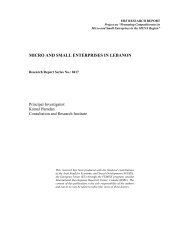local employment growth in the coastal area of tunisia - Economic ...
local employment growth in the coastal area of tunisia - Economic ...
local employment growth in the coastal area of tunisia - Economic ...
You also want an ePaper? Increase the reach of your titles
YUMPU automatically turns print PDFs into web optimized ePapers that Google loves.
The Tunisian’s un<strong>employment</strong> rate rose from 11.5% <strong>in</strong> 1984 to 13.9% <strong>in</strong> 2004.<br />
Un<strong>employment</strong> among young people (aged from 25 to 29) raised from 12.6 per cent <strong>in</strong> 1984<br />
to 25.2 percent <strong>in</strong> 2008.3 In addition, un<strong>employment</strong> among young graduates exploded,<br />
which is an alarm<strong>in</strong>g situation: un<strong>employment</strong> rate for graduates <strong>of</strong> higher education rose<br />
from 0.7% <strong>in</strong> 1984 to 9.4% <strong>in</strong> 2004 and reached 19% <strong>in</strong> 20074.<br />
The spatial <strong>in</strong>equality <strong>of</strong> economic activities and <strong>employment</strong> opportunities has been<br />
emphasized dur<strong>in</strong>g <strong>the</strong> last decade. Tunisian’s un<strong>employment</strong> rate is characterized by<br />
important regional disparities between governorates. Table 1 shows that <strong>the</strong> highest<br />
un<strong>employment</strong> rates are located <strong>in</strong> <strong>in</strong>terior <strong>area</strong>s with more that 20% un<strong>employment</strong>, aga<strong>in</strong>st<br />
un<strong>employment</strong> rates fewer than 11% <strong>in</strong> <strong>the</strong> <strong>coastal</strong> <strong>area</strong>s.<br />
Figure 2 plots <strong>the</strong> log <strong>of</strong> un<strong>employment</strong> (U) and log <strong>of</strong> vacancies (V) for two groups <strong>of</strong><br />
governorates. The first group is composed <strong>of</strong> <strong>the</strong> three largest agglomerations <strong>of</strong> <strong>the</strong> <strong>coastal</strong><br />
<strong>area</strong> (Tunis, Sousse and Sfax), while <strong>the</strong> second group is comprised <strong>of</strong> three governorates<br />
from <strong>the</strong> <strong>in</strong>terior <strong>area</strong> (Béja, Le Kef and Meden<strong>in</strong>e). As seen <strong>in</strong> this Figure, vacancies and<br />
un<strong>employment</strong> have grown at <strong>in</strong>creas<strong>in</strong>g rates for <strong>the</strong> first group, while <strong>the</strong> number <strong>of</strong><br />
un<strong>employment</strong> shows a dramatic decl<strong>in</strong>e for <strong>the</strong> second group.<br />
2.3 Market forces and <strong>local</strong> <strong>in</strong>equalities: Costs versus attractiveness <strong>in</strong> <strong>coastal</strong> <strong>area</strong>s<br />
We can conclude from Figure 3 that, as production cost <strong>in</strong>creases <strong>in</strong> <strong>the</strong> governorate <strong>of</strong> Tunis,<br />
Sousse and Sfax, some activities are de<strong>local</strong>ized <strong>in</strong> specific neighbor<strong>in</strong>g governorates:<br />
Zaghouan, Nabeul and Mounastir, but never <strong>in</strong> fur<strong>the</strong>r ones. Relocat<strong>in</strong>g and decentraliz<strong>in</strong>g<br />
<strong>employment</strong> and firms from Tunis, Sfax and Sousse (<strong>the</strong> three largest agglomeration <strong>in</strong><br />
Tunisia) is due to <strong>the</strong>ir negative externalities (<strong>in</strong>creased Costs, pollution…) as well as <strong>the</strong><br />
<strong>in</strong>strumental policies; government <strong>in</strong>centives can affect a firm’s location. Nabeul, Mounastir<br />
and Zaghouan are characterized by <strong>the</strong>ir geographical proximity to Tunis, Sfax and Sousse<br />
and <strong>the</strong>ir attractive externalities, such as <strong>the</strong>ir relatively low labor cost and land price.<br />
Therefore, we notice that attractiveness is strongly affected by <strong>the</strong> spatial location, which is a<br />
market force. Consequently, we will take <strong>in</strong>to account <strong>the</strong> market forces, that depend on<br />
economic geography and best support <strong>the</strong> concentration <strong>of</strong> <strong>employment</strong> opportunities, <strong>in</strong><br />
order to identify new ideas for convergence <strong>of</strong> <strong>employment</strong>s levels across different locations.<br />
3. Model for <strong>local</strong> <strong>employment</strong> analysis<br />
3.1 Factors <strong>of</strong> <strong>local</strong> <strong>employment</strong><br />
Follow<strong>in</strong>g Shearmur et al., (2007) <strong>local</strong> <strong>employment</strong> <strong>growth</strong> can be attributed to three<br />
different factors. First, <strong>the</strong> <strong>local</strong> <strong>in</strong>stitutional context (specific actors, <strong>in</strong>ter firm dynamics and<br />
knowledge spillover) can <strong>in</strong>duce <strong>employment</strong> <strong>growth</strong> at a <strong>local</strong> level. But as <strong>the</strong>se factors<br />
<strong>in</strong>clude a substantial qualitative component, <strong>the</strong>y are difficult to be measured. We<br />
approximate <strong>the</strong>m by education and wage levels, which measure stock <strong>of</strong> knowledge and<br />
spatial differences <strong>in</strong> <strong>local</strong> non-human endowments (geographical features, natural resources<br />
or some o<strong>the</strong>r <strong>local</strong> endowments like public or private capital, <strong>local</strong> <strong>in</strong>stitutions and<br />
technology). The second set <strong>of</strong> factors that can affect <strong>local</strong> <strong>employment</strong> <strong>growth</strong> is <strong>the</strong><br />
<strong>in</strong>dustrial structure <strong>of</strong> a region. Several <strong>local</strong> measurable attributes are used <strong>in</strong> <strong>the</strong> literature to<br />
test <strong>the</strong> impact <strong>of</strong> <strong>in</strong>dustrial structure on <strong>local</strong> <strong>employment</strong> <strong>growth</strong>, such as specialization,<br />
diversity and <strong>local</strong> competition. The third lot <strong>of</strong> factors are <strong>the</strong> geographical and historical<br />
structures. Geographic location (for example proximity to market) and historical trends have<br />
been put forward as hav<strong>in</strong>g greater effect on <strong>local</strong> <strong>employment</strong> <strong>growth</strong>. To test <strong>the</strong> impact <strong>of</strong><br />
3 <strong>Economic</strong> Report on Africa 2010, Promot<strong>in</strong>g high-level susta<strong>in</strong>able <strong>growth</strong> to reduce un<strong>employment</strong> <strong>in</strong><br />
Africa.<br />
4 National Institute <strong>of</strong> Statistics – Tunisia (INS).<br />
4

















